by Tom Gaylord
Writing as B.B. Pelletier
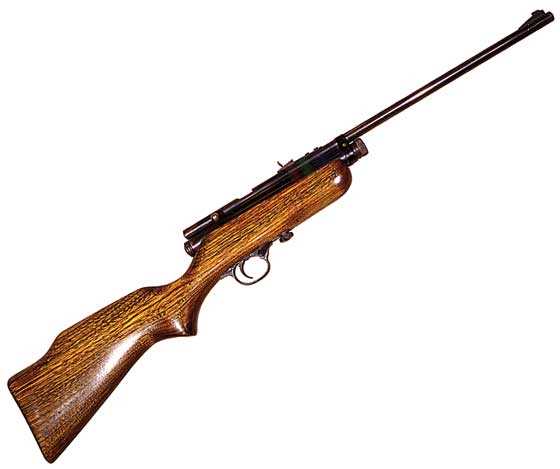
My .22 caliber Crosman 180 is the second variation.
This report covers:
- The acquisition
- Quick fix
- 180 variants
- Trigger
- The 180 valve
- Adjustable power
- Description
- Sights
- Summary
The acquisition
When my wife Edith and I lived in Maryland (1982-2003) we often attended the Columbia Flea Market. Once each month they held a Super Sunday when the market would expand by 500 percent. That was the day all the occasional dealers would attend, and bring the stuff nobody had ever seen. I found some tremendous air gun bargains there! Maybe I will write a report on just that — the deals I found and the deals I passed up. Today, however, I am starting a look at a Crosman 180 that came from that market.
We had been attending for more than a year and I believe I had started writing The Airgun Letter, or was about to. Because I was used to seeing vintage airguns at this market I carried several CO2 cartridges in my pocket, just in case. On this day one stall had this Crosman 180 and a .177-caliber 187 for sale. As I recall they wanted $40 apiece. I asked if they held CO2 and of course the dealer didn’t know. Then I asked if I could try my cartridges and she said yes.
Quick fix
Both guns leaked, which I told her would cost me $30 each to reseal. I was able to negotiate both guns for $40. The 187 was beautiful and the 180 was both tired-looking and missing some non-critical parts. When I got home I tried several drops of Crosman Pellgunoil in the tubes before I pierced the next CO2 cartridges and both guns stopped leaking.
I sold the 187, which is the scarcer model, for $100 at the Baldwinsville airgun show, and kept the 180. A 187 was more desirable in those days than they are today, because the Blue Book of Airguns had not started publishing yet and there wasn’t much information. You can still get a nice 187 for about the same price today.
This 180 was a beater, so I refinished the stock (sandpaper, followed by many coats of Tru Oil) and the metal (cold blue). The gun was light (4 lbs.), reasonably accurate with open sights, and used just one CO2 cartridge, where the Crosman 160 uses two. At this point I should mention that Sears sold a Crosman 180 that was made especially for them. It also used one cartridge, but the gas tube was long enough to hold two. If you swapped the CO2 cap that had a long rod to hold the cartridge against the piercing pin with a 160 end cap that had a piercing pin, that special 180 will accept two CO2 cartridges. You don’t get more power, just more shots.
180 variants
The 180 exists in two variations. The first one was made from 1956 to 1959, and had a simple direct sear trigger and a crossbolt safety that extends through both sides of the stock.
Trigger
My gun is the second variation. The second variation has the much more refined “crossbow” adjustable trigger I have written about. These were made from 1962 to 1966 and exist in greater numbers than the first variation, but that adjustable trigger makes them more desirable and therefore slightly more expensive.
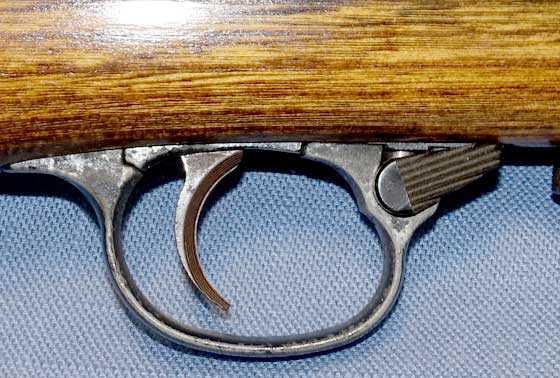
The ribbed lever on the right is the safety lever. Rotate it down and back to make the gun safe. This one is plastic, a replacement for the metal one that was missing.
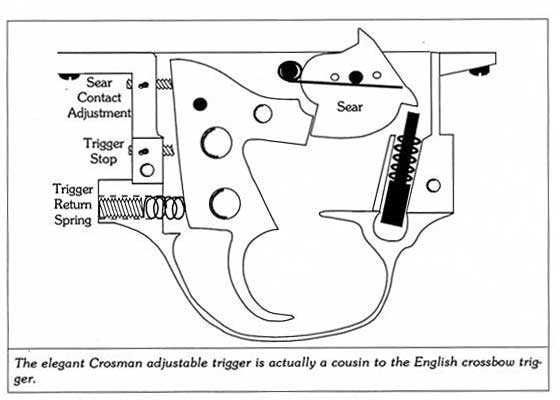
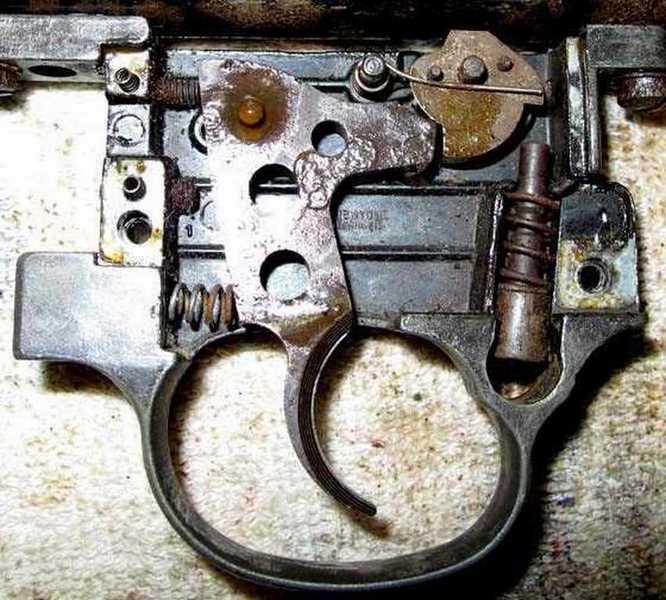
The sideplate has been removed to expose the trigger parts. Trigger pull weight, sear engagement and overtravel are adjustable.
The 180 valve
The valve in the 180/187 is very similar to the valve found in the 150/157 pistol. It doesn’t pierce the cartridge when the end cap is screwed tight. The gun has to be cocked and fired one time to pierce the cartridge. This is a more positive way of piercing, but it can also fake out someone who has never encountered it before.
The rifle is cocked by pulling back the cocking knob at the back of the receiver tube. The bolt is simply for loading the pellet and sealing the breech. The cocking knob has three clicks as it is pulled back. The first just sets the trigger and nothing else. The second engages the striker for a low power shot to save gas and the third click is warp drive, which in a 180 is more of a model T running wide open.
Adjustable power
The power of both high and low power settings is adjustable within limits. There is a hole in the cocking knob. Align it with an Allen screw inside the striker system and you can adjust the spring tension. I will talk more about that in Part 2.
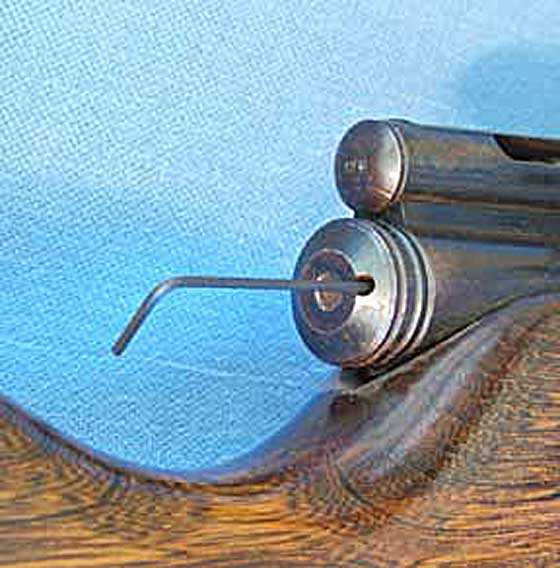
Align the hole in the cocking knob with the Allen screw inside and you can adjust both power levels within reason.
Description
The 180 was intended for young shooters, but it is sized to be equally suited for adults. Overall length is 34-inches. Length of pull is 13-1/2- to 13-3/4-inches, depending on where you measure the butt. It weighs a nominal 4 lbs. The barrel is about 18 inches long. Those small dimensions come together in a rifle that’s light and easy to carry and shoot. It’s .22 caliber, although I must say in this rifle, .177 caliber seems more appropriate. A lot of 180s were converted by swapping barrels in the days when those parts were available. But conversions also went the other way, so it probably balances out.
The stock is wood that is a dense plywood. It can have a beautiful grain if it’s cut the right way. Mine is more plain than others I’ve seen.
Sights
The front sight is a plain square post. Mine is plastic because there was none on the gun when I got it. Back in the 1990s when I bought it Crosman still supplied parts for all their old airguns.
The rear sight is adjustable in both directions, but the adjustments are crude. A stepped elevator handles elevation and an oval slot and screw allows the sight to be slid in either direction for windage.
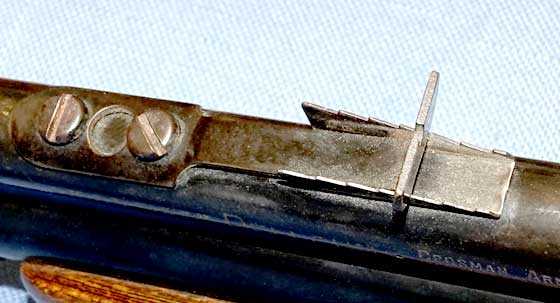
The 180 rear sight is adjustable but crude. Elevation is via a stepped ramp asnd windage is a screw through an oval hole.
Summary
The 180 is a smaller, simpler and lighter rifle than the 160 that everyone knows about. It’s very handy. Edith, liked ours almost as much as the Sheridan Blue Streak. She made me promise to keep it, and so I have.

B.B.,
Never paid attention to that hole at the cocking knob. I had thought it was simply an oil hole! Oh to get back an airgun of my yesteryears.
Siraniko
Siraniko,
Yeah, those good ones we let get away. 🙁
B.B.
BB,
LOL! It comes with a laminated stock?! You pay extra for that these days.
If I was to get a CO2 rifle, I think a 180 or 187 would be an excellent choice. I can see where this would be great for when you need to protect the homestead from a pack of feral soda cans.
RR,
In those days is was cheaper to use laminated wood. These are not the laminates we see today. They are a plain grade of hardwood laid down in thin sections.
B.B.
BB,
I know, but it was probably still more durable and less susceptible to warping. It looks pretty good also.
RR,
It was an excellent product! I wish it could be cost-effective today.
B.B.
B.B.,
Was the 187 available in the Sears 2 Powerlet version? I’ve always thought the wood, however Crosman did it on these, is just plain beautiful.
Michael
Michael,
I don’t know that Sears made their special 180 in .177. They also sold the regular Crosman models. Isn’t that confusing?
B.B.
B.B.,
Off-topic, but I have a favor to ask. This fellow’s Walther LGV makes the same exact buzz (actually a BINNGZZ) as mine does. If you listen carefully from 8:43 to 9:52. (Obnoxious music warning: do NOT listen to the earlier part of the video at loud volume.)
Does this sound normal?
https://www.youtube.com/watch?v=1JPqfvHBEQc
Michael
Michael,
I will listen later this morning.
B.B.
Michael,
No, that does not sound like anything normal. The sound isn’t that good, but there is a harmonic I have never heard in a springer.
B.B.
B.B.,
I purchased it new from AoA in April 2014. Umarex’ warranty “covers any defect in workmanship and materials.” However, seals and mainsprings were out of warranty after 18 months. And I would have to pay for the shipping both ways.
Having heard that distinctive twang and buzz, what does your experience suggest? Kinked spring? Loose piston rod? (My chrono is in storage, but using the phone book penetration method, it is up to spec power-wise, about 95 percent as powerful as my TX200.)
Sending it to Umarex is not the best if it’s just a spring I’d have to pay for regardless, but If the problem is major, then Umarex is the best bet.
Any advice?
Michael
Michael,
It’s time to open a channel of communications with Umarex directly. If anyone knows what is happening it should be them.
B.B.
B.B.,
Thanks. That is the nudge I needed. Jim M. gave me their contact info, and I’ll do that. I’ll also report back here with an update.
Thanks very much,
Michael
B.B.,
Well, I sent my like-new Walther LGV to Umarex USA last week to have it looked at under the warrantee against defects, and they called an hour or so ago to tell me the air rifle has their clean bill of health. They did not say whether or not they opened it up, just that it was “performing normally,” and “vibration and buzzing like that is normal for an air rifle shooting around nineteen joules. If you wish to quiet it down, you could have us lower the power to about sixteen. Then it would be smoother. At that power, though, that twang is normal.”
I thanked them and declined, preferring to just have them ship it back to me as it has been.
Care to look inside and write a blog installment on solving the mystery, hint, hint? ;^)
Michael
Michael,
If there are also small grey and black feathers leaving the barrel at high speed,I’m pretty sure that someone has managed to trap a very tiny Canada Goose inside the bowels of your gun. 😉
Halfstep,
It IS kind of a honking sound, isn’t it?
Michael
Is the Crosman 2260 a more or less direct descendant of this one? Looks like the trigger is pretty different but the CO2 piercing system (first “shot” pierces) sounds similar…
HS,
More or less. Crosman has a tradition of using a design for a very long time.
B.B.
Ha, I guess I could have (almost) answered my own question…
Hiveseeker,
I have a 2260. Love the looks and feel of the gun, but, can’t stand those awful excuse for open sights they use on it! I also have a Benjamin EB22 that I adore the weight, build, power and feel of the pistol, but the open sights are the worst. I’ve searched the web over looking for someone that offered different sights for it, but found none 🙁
Doc
Thanks, Doc. The sights on the 2260 look pretty close to what I had on my old Crosman 2100 decades ago–i.e., not much improved. My vision is good and I do okay with iron sights but really enjoy the quality scopes you can get at a reasonable price these days.
Your 2100 is probably like mine…metal receiver and convention open sights. The trouble with my 2260 is the rear sight is too close to my eye. The notch is useless that close. The “flip” side is a peep. It’s not crude. I’m not much into scopes. They are ok, but I love good quality iron sights. Just me.
Doc
I have one of the 180 first models. It’s in great shape and still holds CO2. I shoot it just a little but keep in stored with a CO2 cartridge in it.
Mike
Reminds me of the QB 78 and 79’s a bit.
Gunfun1,
It should. It’s bigger brother, the 160, was the base from which the QB series came from.
Siraniko
GF1,
The QB 77 was created from the finest features in the Crosman 160. It sold for around $200. Then the Chinese knocked it off (they were making the 77 for Americans) and produced the QB 78. For many years the 78 was a crap-shoot for quality, but finally the Chinese realized that the customer really matters. The quality has improved a lot, and the price reflects that.
B.B.
“Edith, liked ours almost as much as the Sheridan Blue Streak.
She made me promise to keep it, and so I have.”
(And that’s very cool, of course.)
The blog needs a “Like” button!
BB,
You know, I would not do it to this particular one, but this would probably be an excellent model to do that HPA conversion for the Crosman pistols. It would indeed be a dandy plinker.
RR,
I knew somebody would suggest that! Yes, it would work.
B.B.
Nice little rifle. I too have a second series. Reminds me of an M-1 carbine, right down to the safety operation. My only criticism is poor sights and no scope grooves.
I have a shaving request. You mentioned that stropping immediately after shaving is a bad idea. I have to admit that sounds like a myth to me. Do you have references to explain why that is? if not, I wonder if you can devise an experiment to verify the advice?
On a related topic, I hope you can find a way to photograph some of your razor edges through your new magnifier. I’m interested to see microscopic images of “good” and “bad” edges.
Butler,
I didn’t say that. One of our readers said it and I repeated it. At the time I wasn’t sure what was right. I now believe that stropping immediately does not hurt the razor. One clue is that several sources that sell razors and blades say to do it.
I have some microscopic images to share. I have laid off the shaving article awhile because it’s so far off topic for airgunners. But I have advanced quite far since the last article and could write several large reports.
Monday will have a little taste of the topic, and maybe I will try another one soon.
B.B.
Hi guys,I happened across this and wish to point out that I got that theory? directly from Dovo razor mfg.
I guess I could/should have tested out the theory before repeating it on the internet.
I just lack the follow through to investigate it.If we just for giggles pretend it is true I think it would not be a drastic difference.You have to appreciate the established fact that microchips themselves are both minimized AND sharpened in the stropping process.That implies that the “cause” is also a partial cure over time.
That leads me to conclude that a scanning electron microscope would be necessary to debunk this notion…..oh,and I guess you would need a Dovo razor. 🙂
Frank,
I tried to shave with my new Dovo after stropping it. No deal.
I then got 20X magnifying glasses that are also illuminated. With them I can easily examine edges. The Dovo was sent out without a bevel! I am going to have to set a bevel and completely hone it before I can shave with it. A new product shouldn’t come that way.
I will cover that sharp knife you sent in the next report!
B.B.
Well that is just nauseating to know….that there are precious few straight razor makers AND they are selling crap.I now REALLY regret repeating anything that came from them.Dovo must have edited out the guy or gal sleeping at the honing station.
Like ALL the others,I anxiously await reading it. You look marvelous in “Stranger Guns”…..and I would love to replicate the gun wall.Storage and display are an issue at my house.Airgun envy kicked in several times…..I think I’m going into relapse.
B.B.,
Nice little gun. Nothing on the looks of the wood would speak to it being a laminate of any sort. Both photos indicate no typical laminations. The only thing I can think of is 2 rather thick boards glued together,… technically making it a laminate at that point. Assuming that to be the case,.. the only “line” would be directly at the top and bottom. The Maximus measures 1 3/4″ wide at the thickest part of the forearm as a reference point. Am I missing something from the photos?
Chris
Chris,
The laminations are thin and do not run parallel to the stock like. Look for the dark gluelines.
B.B.
B.B.,
I have looked and even blew up the picture(s) to 400% on the laptop. I still can not tell that it is not 1 solid piece of wood. ** Perhaps in the next blog you could do a super close up of an area on the wood that highlights this type of construction? ** It has me 100% fooled.
I can only now assume that the layers all run parallel to each other and are stacked from top to bottom and must be very thin (as opposed to every other layer being 90 degrees to each other as in modern plywood). Areas to the front facing and rear facing would show end grain characteristics too, I would think.
It may seem trivial, but I think it be important for us to be able to recognize this should we happen upon it.
Chris
I thought you were supposed to steel blades to straighten them after every use, but maybe that applies only to knives and not razor blades. I hadn’t heard about stropping, but I don’t see that it would hurt. If you are going to strop at some point, the time delay after previous use shouldn’t matter. I’m glad to read anything about sharpening.
As for today’s rifle, I would say that there is a tiny gun. I can see how the length of pull could be normally sized, but there’s almost no room to grip the fore-end.
geo0791, yes the .458 Winchester magnum looks ugly to shoot. The one time I saw it in person, it gave a severe jolt to shooters who were standing. As a big game rifle, I’m sure it was designed for offhand, so the designers didn’t care about the rested recoil. And they probably figured that you would rather feel a heavy recoil than get killed by an animal. After shooting my Mauser rested, I can believe that the .458 could break a shoulder, but it is still possible to shoot. At this same encounter, the owner of the rifle fired it from a rest and hit the center of the 50 yard target with the iron sights. I hear about people shooting tight groups with a .375 HH magnum although not any higher calibers.
Matt61
Matt,
That tiny forearm is the defining visual statement of the 180, but the LOP is adult-sized. From everything I’ve read, with the power adjusted to maximum, a healthy one can really thump, too.
Michael
BB—Have you watched the tv series “forged in fire” ? The bladesmiths use a variety of methods to sharpen their knives ( and swords, axes, spears, etc.). I think that you and many of our bloggers would enjoy this series, watching blade smiths create weapons from raw materials , and putting them to the ( often torture) test. ——-Ed
Ed,
I watch every episode. It’s like a cooking show for men. I love it!
B.B.
B.B.,
Some cooking shows are clearly for men. Personally, I find Giada De Laurentiis and Rachel Ray to be superb hosts. =8^D
Michael
Michael,
True, true. I watch a lot of them. PBS (Public Broadcasting System) has some real good ones on Sat. in my area with Cook’s Country and America’s Test Kitchen being 2 of the best. They really explain the science of cooking and what happens to and within the food. That is what separates the trained chef and the home cook. They know that stuff. Technique.
They offer side products like books. The Science of Good Cooking is stellar. Not over the top in anyway, easy to understand and full of exceptional recipes that are thoroughly researched and tested and tweaked to be the very best. Cook’s Illustrated is their magazine.
I am 4 hrs. into beef stew today and only 1/2 done. It will be 5-6 quarts using 5# of chuck roast. Thick, meaty and tons of flavor.
Ed,
My wife even enjoys watching it.
“This weapon will kiiill.”
RidgeRunner,
The correct term he uses is, “This weapon will KEAL.” (Keep Everyone ALive).
Siraniko
Sorry, I never was very good with phonetic spelling or acronyms.
RidgeRunner,
Don’t think too many know it anyways. I think he mentioned it only once if ever. I believe I found out about it through social media.
Siraniko
Matt61—- Have you ever seen the African adventure films that Martin and Osa Johnson made in the 1930,s ? ( Or read their books ? )Osa probably weighed 99 lbs, but she had no trouble shooting elephant rifles ! I have two .458 win rifles. One is a Savage 110 that I had rebarreled to .458 in the 1980,s.. I only shoot 45-70 loads in it now because the recoil lug has bent from firing 2 or 3 hundred full power 500 grain loads. I should have had the gunsmith add a second recoil lug to the barrel . My other .458 is a Mark X Mauser. Both rifles shoot 45-70 loads into 2 inch (or less) 5 shot groups a t 100 yards. I shoot the full power loads offhand, using shooting sticks. I have shot a few from a sand bag rest. I can usually shoot 5 or 6 shots before the recoil becomes excessive .I do not use a lead sled, or a shoulder pad of any kind. I once had a friend who bruised his shoulder and cheek every time he fired an M1 carbine ! I have a .375 H&H magnum, also a Mark X Mauser. Most of my 200 yard groups ( sand bag rest ) are under 3 inches. The 110 and the .375 are in Bell & Carlson stocks. When I was hunting in the R.S.A., my guide had a new Musgrave .375 in a wood stock. It weighed 2 lbs more than my Mark X . The felt recoil was greater with the Musgrave ( same .300 grain loads). A modern synthetic stock can turn a heavy recoiling rifle into pussycat. My Ruger .338 came in a factory synthetic stock. I could not even shoot 20 rounds ! A Bell & Carlson stock tamed the recoil. When I began shooting in high power rifle matches, I used the 1903 and 03-a3 rifles. We shot them on the shoulder in timed and rapid fire. My clubmates and me competed against M1 Garands. We would not have been able to ,if we had to take the rifle off our shoulders to reload. I suppose that the thousands of rounds that I fired through my 1903 s taught me how to manage recoil. ——-Ed
BB and Fellow Airgunners
Christmas morning, 1962. My friend and I received airguns as gifts for Christmas. I received a Daisy 1897 lever action BB gun, and my good buddy received what I would assume was the Crosman 187, as it was in .177cal. We were both over the moon over our good fortune. The Crosman 187 gave about 35-40 accurate shots on high power. Unfortunately, it was difficult to count the number of shots as the co2 cartridge was sealed like a pop bottle, and very prone to leakage. You were never sure if you had a full cartridge or one with less then an acceptable amount of co2 left in the cartridge . Of the five extra cartridges he received with the gun, only three seemed to be fully charged. The other 2 cartridges gave 5, and 12 shots due to leaking co2 cartridges. For a couple of 12 year olds with $1.00 a week allowance, the Crosman was not a gun my buddy could afford at that time. I remember the gun being quite accurate, but extremely loud when shot in the basement. This prevented us from shooting in our back yards. Oh well, there were plenty of open fields around our houses where we shot feral pop bottles. Pop came in glass bottles then, and not aluminum cans.
I believe my buddy traded the Crosman 187 for a spring piston break barrel after one week, and two of five co2 cartridges being almost empty. I would have liked to have taken the Crosman to one of the fields nearby to see what accuracy it was capable of. Unfortunately, it was the dead of winter, and shooting outside in the cold winters of Calgary, Alberta with co2 was an exercise in futility.
Until I saw the picture, and read the article on the Crosman 180, I had no clue as to the model number of the airgun. Your article on the Crosman 180 brought the memories flooding back to me. I’ll be looking forward to future articles on velocity, and group size. I realize your airgun is a .22cal, but it shouldn’t be too hard to calculate if this airgun would have shot with the same in accuracy in .177. The velocity should be higher as well due to the use of a smaller, and lighter pellet. Would you happen to have any of those trash can look-alike .177 pellets lying about? Just to show others what we were up against 50 years ago compared with today’s accurate pellets.
Ciao
Titus
Titus,
I have .22-caliber ashcan Crosman pellets that I planned to shoot to show folks how it used to be. I also have several bottlecap cartridges, but they have probably leaked off by now.
B.B.
B.B.,
I just watched the latest episode of Stranger Guns, and it is a delight,
https://www.youtube.com/watch?v=JS9DKN-Een8&feature=youtu.be&trk_msg=S4DASB7NI5C4DFQ9TS9IIU0LV0&trk_contact=0SRBFNPOBGPNVB4I8N1KLFVGS4&trk_sid=F7RM5PHQLHUR67O7AK26OB3OF8&utm_source=Listrak&utm_medium=Email&utm_term=View+New+Video&utm_campaign=2017+Video&utm_content=Stranger+Guns%3A+Tom+Gaylord
Michael
Michael,
Thanks for that link. That came out pretty good, don’t you think?
B.B.
B.B.,
You’re entirely welcome. I urge everyone here to check it out.
I thought it was excellent in every respect. The production values and comfort and ease exhibited by the host and you were top notch — it was like watching you appear with Merv Griffin, Mike Douglas, or Jay Leno.
It was especially cool to see some of these air guns handled and used in action, rather than just as still photos.
Above all the K31 trainer was really amazing to behold. The way you slid it into the action was incredible. I’ll bet no one who watches that will have seen anything like it before. It was a fascinating thing to read about in your reports, but to actually see you pull it from its original box and slide it in, load some BBs into it, cock it, and to see it shoot, well, again, amazing. I’m glad you made sure to describe the intricate design, including the ball bearing atop another ball bearing and the use of finely wound twine as a spacer. And your quip about when you received it, it was like all old BB guns, jammed with a bunch of old BBs, was priceless. Most of us can relate to that.
My hope is that in the not-too-distant future you come back for a second installment. How might folks marvel at the Turnpike Toll Gun, for example?
Congratulations on the episode. It was by far their best.
Michael
Michael,
The Turnpike Toll Booth Gun! I forgot that?!!!
Next time for sure,
B.B.
I remember that gun when it was reported on. Cool gun.
BB,
Just watched your Stranger Guns episode myself. I can well imagine that a couple of those would be welcome at RidgeRunner’s Home For Wayward Airguns. Nice suit. 😉
RR,
I noticed the suit too. The Godfather was quite natty.
Michael
Michael,
“natty”? I like odd words and that is one that I have never heard. In what context were you using it with reference to the suit/airgun-video? I would assume that it means something akin to,.. sharp, well dressed. Where did it originate from? A movie? A common term from a yesteryear?
Chris,
A good synonym for natty would be “dapper.”
Michael
Michael,
That,.. I know,… though it does predate my own vintage by a few years. 😉 Thanks!
Chris,
Unfortunately, it does not predate mine. I did understand the word. Maybe that is why I am so attracted to the very old airguns.
B.B.,
I just watched it also. Very nicely done and you look quite sharp. I am not sure if it possible, but it would be nice if you could link stuff like that (stuff you are part of) as they come out. Maybe just a quick mention at the end or start of the blog w/link. Not all of us cruise other sites on regular basis, even though we may have them saved in Favorites. I for one would appreciate it. Just an idea.
Chris
Chris,
I wasn’t aware this was out yet.
B.B.
B.B.,
That is good to hear, that you first heard it was out, and successful at that, from friends/fans. I imagine it makes it all the more gratifying.
Michael
BB,
Just watched you and John in “Stranger Guns”. What a great episode! It was neat being able to see the action of the Hakim operate and the size and build quality of the trainer. Heck, who am I kidding, they were all neat and the fact that I’ve recently read about three of them in your blog made them even more relevant to me. And, as sharp as John always looks in this series, he ain’t got nuttin’ on you, young man!
BB,
I enjoyed the Stanger Guns episode and video seeing some of the guns you have reviewed on the blog. I hope that you will do more Stanger Guns episodes.
I found one blog post on the Skan M32. Were there more?
For some reason I can’t get the copy and paste function to work on my iPad. Hopefully I typed the link correctly.
https://www.pyramydair.com/blog/?s=Scan&btnGo=
If not try searching for scan (not Skan) in the search box.
Jim
I hit post accidentally. I intended to add that I would like to learn more about this gun.
Jim
Jim,
That’s the only report I ever did on the Skan. It came from the Airgun Letter days in the 1990s.
B.B.
BB—I enjoyed watching stranger guns. However, I would like to voice my opinion re some minor points—While I like the old Dutch masters style of portraiture, the real stars of the show are the guns. I would like brighter lighting and have the camera spend more time on the stars and less on the people. I also expected to see some targets to show how the stars performed. Another point is the positioning of the guns . Some viewers like to use captions. The guns are often at the bottom of the screen , and that is where the captions cover them.——-Ed
Ed,
I couldn’t agree more about the lighting! I don’t care to be seen in any videos, but I had no choice. It is the guns that matter — not the drama!
B.B.
B.B.,
I do like the “club chair and drawing room” setting very much as it suggests an overall sophistication for the subject matter. So many “gun videos” are manic, hyper-energetic and frankly juvenile. This video provided a welcome contrast to that. That said, the light on the air guns themselves could be brighter while maintaining the softer light on the host and guest, and the surface beneath the air guns could be lighter to provide better contrast.
Michael
Awesome video, great setting, great guns, and great info- tainmen. I’m super curious about the chairs sitting on the barn porch, they’re very well built I’ve never seen anything like them? But hey everything is bigger in Texas right.
Kind of “sleepy” up in here ya’ all!,.. don’t you think? No post since 3:38 AM,… at least. Me? Today I went out for a bit of squirrel gettin’. No luck. Winds to 30-40 and then calm, for 1 minute. A front moving through. I did however get to see Maple spinners come down hard like rain. Downdrafts. Leaves drifting down ever so steady, only to be blown straight up 30′,.. from an updraft. It can be dead calm were you are at,.. and you can hear very hard wind coming from a quarter mile away. Some birds and squirrels do make near the same sounds. I am still working on figuring that one out. Those little suckers are elusive.
All in all,… fine day. Hope you all had the same,… Chris
What a great old gun!! Glad to see airguns that bring us back to our roots! I have a bunch of old crosmans (and others) in the closet that i save for winter projects. Don’t have a 180 yet though. I rebuild them one by one and give them to friends and family. I have all kinds of airguns up to the newest and most advanced, but i still have a place in my heart for these old “simple” plinkers!!!
Way late to the party on this blog but just purchased a 180, great rifle. One dispute with your write up the stock is not a laminate it is Elm which has that striking liniar grain. Used on many of Crosman guns of that period. I speculate because it was cheap given Dutch Elm disease was kill these trees at that time. See grain pattern here:
45flint,
So that is Elm. Well, I just learned something. Thank you!
B.B.
Grain pattern of Elm: